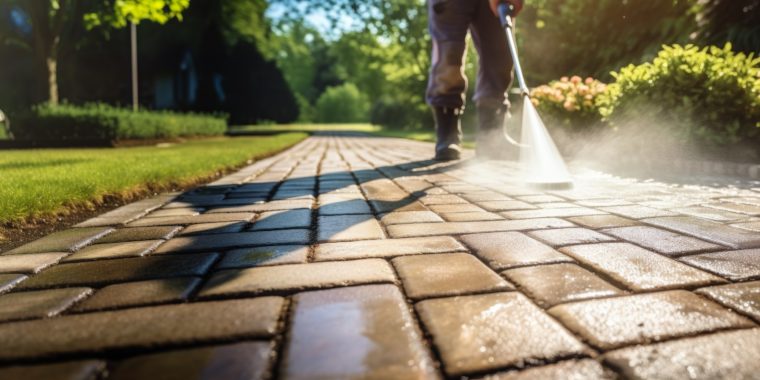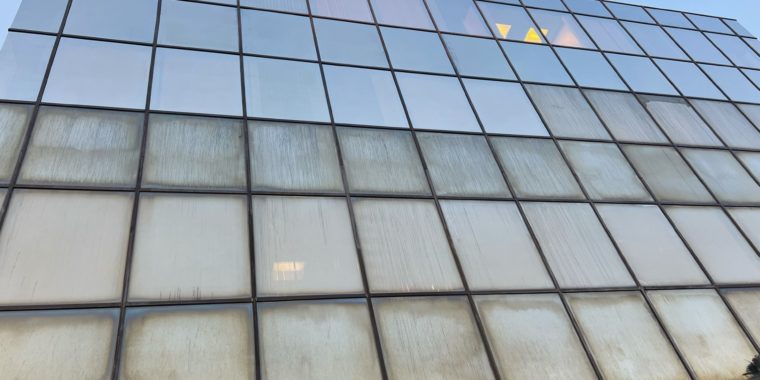Adding pressure washing to your routine building maintenance strategy is a simple yet effective way to achieve a clean and attractive facade. In spite of its simplicity, pressure washing is an often neglected strategy for maintaining a building’s exterior thought to be reserved for the toughest of stains or addressing years of neglect.
Pressure washing revitalizes surfaces by cleaning and removing pollutants such as oils, mold, graffiti, and rust, thus making your building appear years younger. However, removing all those pollutants also contributes to your building’s structural longevity and can make walkways safer. In this article, we will walk you through the ins and outs of pressure washing, including what you should pressure wash and what you shouldn’t, along with the benefits of adding pressure washing to your routine property maintenance and spring cleaning.
The Dual Benefits of Pressure Washing: Aesthetic and Structural
In spite of its deep roots in physics, pressure washing is fairly straightforward. A water pump accelerates water creating a high-pressure stream. The water is then directed through a hose and out a spray wand. Users can tackle different levels of cleaning tasks by adjusting the pressure and changing the nozzle.
Getting the most out of your commercial property requires proper maintenance that addresses its aesthetic appeal and structural integrity. Pressure washing shines in this facet, as it supports both of these goals. Leveraging this type of facade maintenance will improve your curb appeal, thus adding value. In addition, pressure washing can also remove harmful pollutants capable of breaking down sealants and other vital materials designed to protect your property.
Can You Pressure Wash Your Building’s Facade?
The type of material being pressure washed, the level of pressure, and the nozzle all factor into whether or not you can pressure wash your facade. The pressure or water flow is measured by pounds per square inch (PSI) or gallons per minute (GPM). To better understand this, let’s take a look at the three levels of pressure washers.
- Light-duty pressure washers – up to 1900 PSI (2 GPM) and are designed for residential requirements.
- Heavy-duty pressure washers – top out at 2800 PSI (3 GPM) and can tackle most commercial requirements.
- Industrial pressure washers – max out around 7000 PSI (5 GPM) and are more efficient at taking on the toughest tasks.
To put that in perspective, an automatic car wash operates at 1,000 – 1,200 PSI, while a pressure washer up to 7000 PSI can remove graffiti and paint and cut through wood. The U.S. General Services Admission (GSA) advises against pressure washing porous materials (red brick, marble, stone, etc.) due to the risk of severe damage.
The nozzle on the pressure washer determines the cleaning pressure. Without the nozzle, you would just have a motor-powered garden hose. The lower the angle of the nozzle, the more intense the spray pattern. For instance, a 0o spray pattern produces a laser-esque stream useful for tough jobs, while a 40o spray pattern is wider and softer, making it ideal for more delicate surfaces. Turbo nozzles rotate and, when combined with a 0o spray pattern, have more power and cover more ground which can speed up the cleaning process.
You must also factor in the materials you are pressure washing, as using the wrong combination of pressure and nozzle can damage them or produce poor results. Companies providing professional pressure washing services often have specialized equipment to transport pressure washing equipment to hard-to-reach spaces or where water is inaccessible.
So the answer is “Yes”, you can pressure wash your facade if you do it correctly. This is where leaning on professional expertise can make all the difference. Professional pressure washing companies know what PSI, nozzle, and technique each job requires without damaging your property. Next, we will cover which technique works best in various situations.
Choosing the Right Technique: High PSI vs. Soft Washing
Soft washing offers a gentler approach through low-pressure water, often combined with specialized cleaning solutions. This technique effectively removes dirt, algae, moles, and other contaminants and is ideal for those porous surfaces we mentioned. High PSI pressure washing harnesses the power of high-pressure water to tackle tough stains and build-up on durable surfaces. It’s an excellent choice for areas that endure heavy use and require deep cleaning.
Ideal Applications for Each Method
- High PSI Pressure Washing
-
- Sidewalks and curbs: Removes gum, stains, moss, mold, and grime effectively.
- Walkways and retaining walls: Cleans deep-seated dirt and revitalizes the appearance.
- Loading docks and dumpster pads: Essential for sanitation, and removing oil, grease, and debris.
Just like doing dishes at home, hot water works best for the toughest jobs. When high PSI isn’t enough, hot-pressure washers may be required to achieve the desired results. Rusting, for instance, is extremely difficult to remove. It’s also a good sign of an underlying issue that needs to be addressed, or that same rusting will return.
- Soft Washing
-
- Exterior facades: Protects against damage while cleaning, especially those made of materials like vinyl, wood, Exterior Insulation and Finish Systems (EIFS), or certain types of stone and brick.
- Roofs and gutters: Removes mold and mildew without risking structural damage.
- Landscaped areas: Using harmful chemicals to speed up the cleaning process can easily create a costly landscaping problem. Areas above sensitive vegetation require a mix of gentle psi and the proper chemical that gets the desired result while taking avoidable damage out of play.
With the right technique, pressure washing keeps your property clean and well-maintained, preventing costly repairs.
Revitalize Your Property with Pressure Washing Services
Pressure washing revives your property, improves safety, and removes harmful contaminants capable of causing damage. It’s an effective way of keeping your property looking its best and a must-add for most property’s year-round upkeep. We take on pressure-washing projects of all scopes and sizes, including facades, parking garages, loading docks, and more. Here are some features that help us stand out from the crowd.
- Pressure Washing Expertise: Our pressure-washing team knows precisely what technique, nozzle, and angle to use on various building surfaces.
- High-Rise Pressure Washing: We understand what it takes to pressure wash the highest heights with the utmost safety precautions.
- Sustainability Mindset: When jobs arise that require chemicals, we leverage our expertise to choose the appropriate chemical cleaning solution to restore your facade’s appearance without harming your facade or the environment.
Contact us today for a quote, and let our team exceed your expectations.








